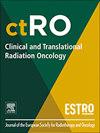稳定透明质酸间隔剂在SBRT治疗腹膜后癌中的应用:病例系列和剂量学分析
IF 2.7
3区 医学
Q3 ONCOLOGY
引用次数: 0
摘要
目的探讨稳定透明质酸(sHA)间隔片在腹膜后植入对腹膜后肿瘤立体定向放射治疗(SBRT)的临床适应症、术后并发症及剂量学影响。患者和方法本回顾性研究分析了2例腹膜后病变的SBRT:原发性左肾细胞癌和右肾上腺少转移性肾细胞癌(RCC)病变。在这两种情况下,经皮将sHA间隔器插入肠和病变之间。对于肾脏肿瘤,在腹腔镜和超声引导下放置间隔器,对于肾上腺病变,在CT引导下放置间隔器。原发肾损害的处方剂量为42 Gy,分三次;肾上腺损害的处方剂量为40 Gy,分五次。在两种规划方案下对剂量学参数进行了评估:(1)不使用隔离剂,遵守桨管约束;(2)使用隔离剂。结果原发性左肾癌患者的PTV - D95%由处方剂量的67.9%提高到99.5%,提高了46.5%。PTV D99%从54.5%增加到86.7%,反映出59.1%的改善。大肠的最大剂量从28.2 Gy降低到24.4 Gy,并且在间隔剂的作用下,接受24 Gy的体积最小(0.06 cc)。对于右侧少转移性肾上腺病变,尽管肿瘤体积增加了四倍,间隔剂后剂量测定显示PTV覆盖率得到改善,但没有超过OAR限制。两例患者均无术后并发症。结论这是首次报道在腹膜后使用sHA间隔器进行SBRT。在大肠附近插入间隔器可显著改善剂量测定,使更高的剂量达到靶标,同时使OAR剂量保持在安全范围内。需要在更大的患者群体中进行进一步的研究,以评估安全性和优化垫片放置技术,以提高临床效果。本文章由计算机程序翻译,如有差异,请以英文原文为准。
Utilization of a stabilized hyaluronic acid spacer in SBRT for retroperitoneal cancers: A case series and dosimetric analysis
Objectives
To evaluate the clinical indications, post-operative complications, and dosimetric impact of stabilized hyaluronic acid (sHA) spacer insertion in the retroperitoneum for stereotactic body radiation therapy (SBRT) of retroperitoneal cancers.
Patients and methods
This retrospective study analyzed two cases of SBRT for retroperitoneal lesions: a primary left renal cell carcinoma and an oligometastatic renal cell carcinoma (RCC) lesion in the right adrenal gland. In both cases, a sHA spacer was percutaneously inserted between the bowel and the lesion. The spacer was placed under laparoscopic and ultrasound guidance for the renal tumor, and under CT guidance for the adrenal lesion. The prescribed dose was 42 Gy in three fractions for the primary renal lesion and 40 Gy in five fractions for the adrenal lesion. Dosimetric parameters were evaluated in two planning scenarios: (1) without the spacer, adhering to OAR constraints, and (2) with the spacer.
Results
Spacer insertion for the primary left renal cancer significantly improved PTV D95% from 67.9 % to 99.5 % of the prescribed dose, a 46.5 % increase. PTV D99% increased from 54.5 % to 86.7 %, reflecting a 59.1 % improvement. The large bowel’s maximum dose was reduced from 28.2 Gy to 24.4 Gy, and the volume receiving 24 Gy was minimal with the spacer (0.06 cc). For the right oligometastatic adrenal lesion, despite a fourfold increase in tumor volume, post-spacer dosimetry showed improved PTV coverage without exceeding OAR constraints. No post-operative complications were observed in either case.
Conclusion
This is the first report on sHA spacer use in the retroperitoneum for SBRT. Spacer insertion near the large bowel significantly improves dosimetry, enabling higher doses to targets while keeping OAR doses within safe limits. Further research with a larger patient population is required to assess safety and for optimization of the technique for spacer placement in order to enhance clinical outcomes.
求助全文
通过发布文献求助,成功后即可免费获取论文全文。
去求助
来源期刊

Clinical and Translational Radiation Oncology
Medicine-Radiology, Nuclear Medicine and Imaging
CiteScore
5.30
自引率
3.20%
发文量
114
审稿时长
40 days
 求助内容:
求助内容: 应助结果提醒方式:
应助结果提醒方式:


